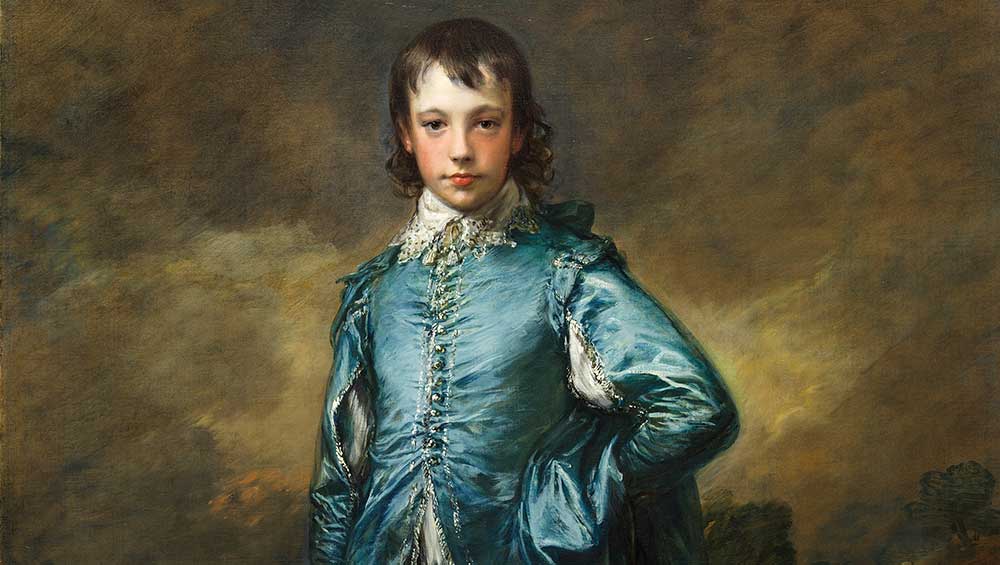
Thomas Gainsborough. The Blue Boy, 1770 (detail). Oil on canvas, 179.4 × 123.8 cm. © courtesy of the Huntington Library, Art Museum, and Botanical Gardens, San Marino, California.
National Gallery, London
25 January – 15 May 2022
by JULIET RIX
A hundred years ago to the day before the opening of this exhibition, Gainsborough’s Blue Boy left London for the US. The picture was a national icon and the most expensive painting ever sold. The American railway magnate Henry E Huntington had bought it for $728,800 (£182,000), about £9m in modern money, though it was his wife Arabella who selected the picture and negotiated the price with the early 20th century’s most successful art dealer, Joseph Duveen.
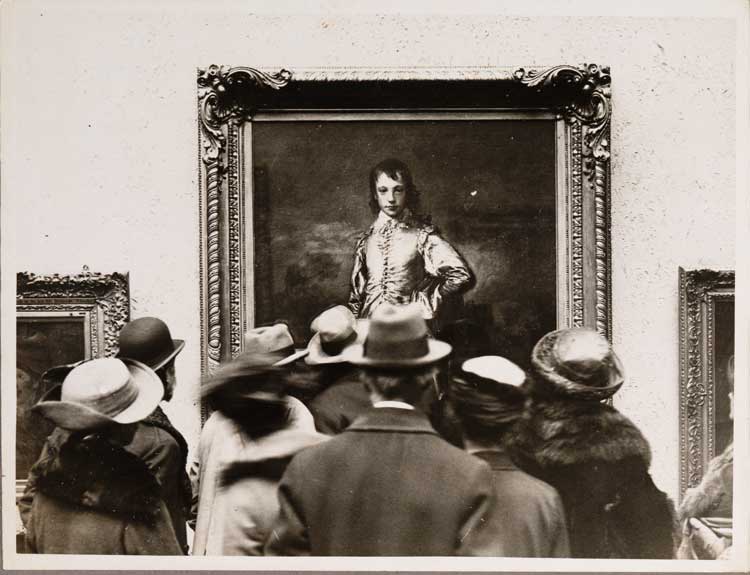
Blue Boy at the National Gallery, London, 1922. Photo © courtesy of the Huntington Library, Art Museum, and Botanical Gardens, San Marino, California.
The Blue Boy belonged to the Duke of Westminster but had been stored in the basement of National Gallery to keep it safe during the first world war, and before leaving for America, it was put on display here for three weeks. The Times newspaper reported that 90,000 people came to bid the boy an emotional farewell, and the then director of the gallery, Sir Charles Holmes, went so far as to write in pencil on the back of this most valuable work of art: “Au Revoir.”
First exhibited in 1770 at the Royal Academy (just two years after it opened), Blue Boy was for Gainsborough a virtuosic statement of intent, a modern take on tradition, a claim to the highest echelons of both British and European Art, and an advertisement.
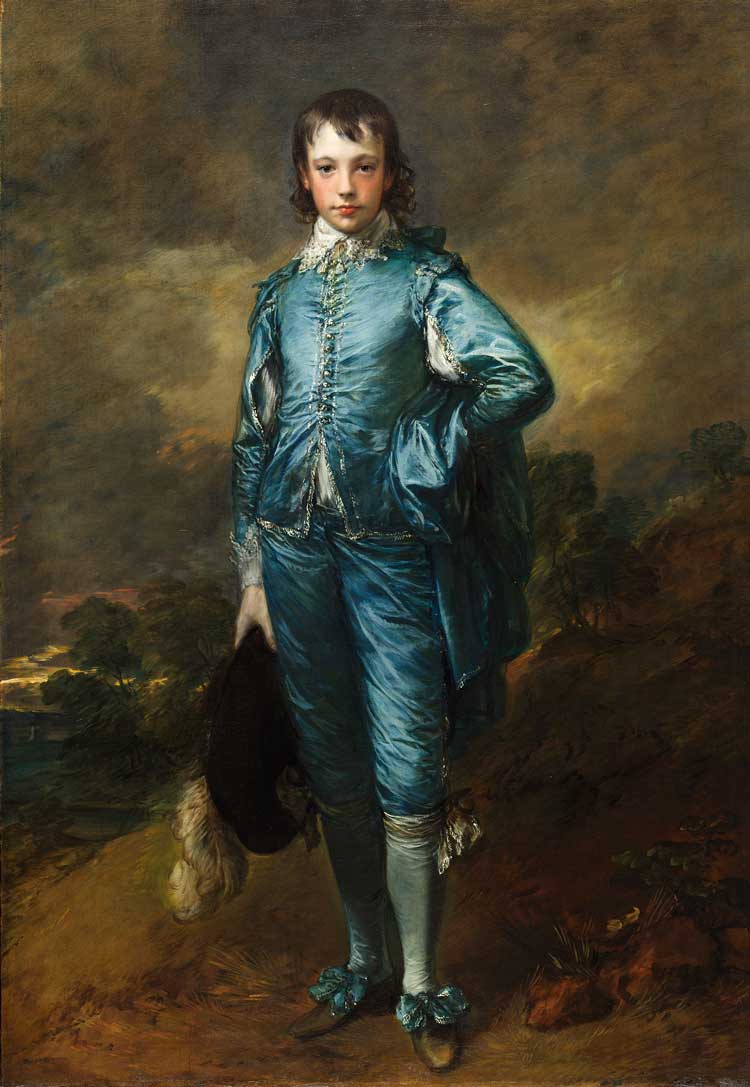
Thomas Gainsborough. The Blue Boy, 1770. Oil on canvas, 179.4 × 123.8 cm. © courtesy of the Huntington Library, Art Museum, and Botanical Gardens, San Marino, California.
Entering today’s exhibition, appropriately hung in the historic part of the National Gallery building, the picture is straight in front of you. The near-life-size boy looks directly into your eyes. His striking blue Van Dyck satin suit glistens – particularly since the recent two-year cleaning and conservation project that has restored its brightness and the contrast of its rich darks and luminescent highlights. The tactile fabric of the boy’s glamorous garments, in the flamboyant Royalist style already a century old, hugs his body in shimmering folds, the jacket slightly open and not-quite-controlled, like a schoolboy whose smart shirt is just a fraction out of his well-pressed trousers. The Blue Boy is both idealised and natural.
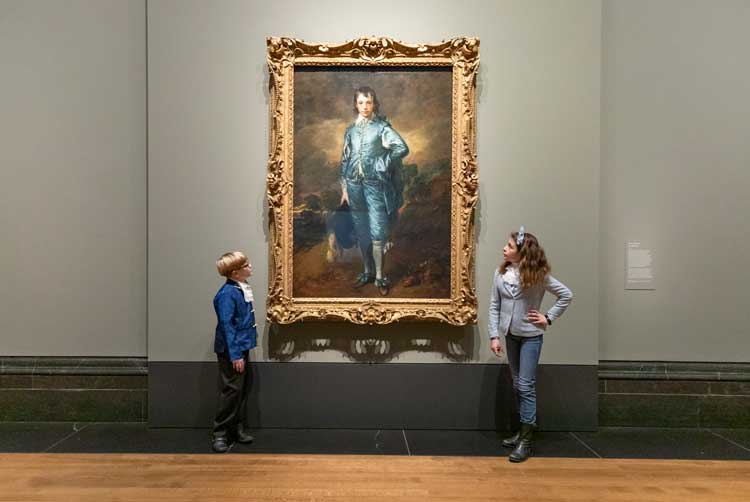
Photocall for Gainsborough’s The Blue Boy at the National Gallery © The National Gallery.
The painting was originally entitled A Portrait of a Young Gentleman, and the identity of the sitter has never been known. It was long assumed to be Jonathan Buttall (1752-1805), son of a wealthy London ironmonger, because of his early ownership of the painting. But more recently it has been suggested that the sitter was Gainsborough Dupont (1754-97), the artist’s nephew. Neither wealthy nor upper class, he was Gainsborough’s only student and sat for him on a number of occasions. While the question of who posed for the picture is a matter of art-historical curiosity, for Gainsborough it was clearly not the point. The boy’s anonymous mix of individual child and archetypal beauty served the artist’s purpose. Allowing the viewer to project on to the picture their own Blue Boy was perfect for marketing, and as the foundation for the national popularity the painting went on to achieve.
The 19th century saw the rise and rise of British art – and the British art market. Early in the century, London was the beneficiary of art dealers deserting Paris amid the Napoleonic wars while, towards the end of the century, the UK’s introduction of death duties drove world-class artworks on to the market. This was a period, too, of burgeoning publication as well as public display. The Blue Boy – so named by 1810 – could be seen at the Duke of Westminster’s grand Grosvenor House home, and appeared in numerous reproductions, on paper, ceramic and chocolate boxes. And let’s be honest, even today, it is not hard to see why.
The Blue Boy was also a “painters’ painting,” says the National Gallery’s curator, Christine Riding. In 1820, the prominent printmaker John Young published a reproduction accompanied by an art historical origin myth. Gainsborough painted the Blue Boy, he said, in opposition to Sir Joshua Reynolds, the then quite newly appointed president of the Royal Academy. Always more of a fan of Italian than northern European art, Reynolds said in his eighth discourse in 1778 (and Young assumed he must have said before this) that the central features of a painting must be in warm colours (reds, yellows). Even great masters such as Rubens and Titian, Reynolds insisted, would not be able to make a harmonious painting with blue as its heart. He cited Titian’s Bacchus and Ariadne (1522-3) as a model for warm-colour-centric art, opposing it to the cooler colour schemes of Flemish masters such as Anthony van Dyck.
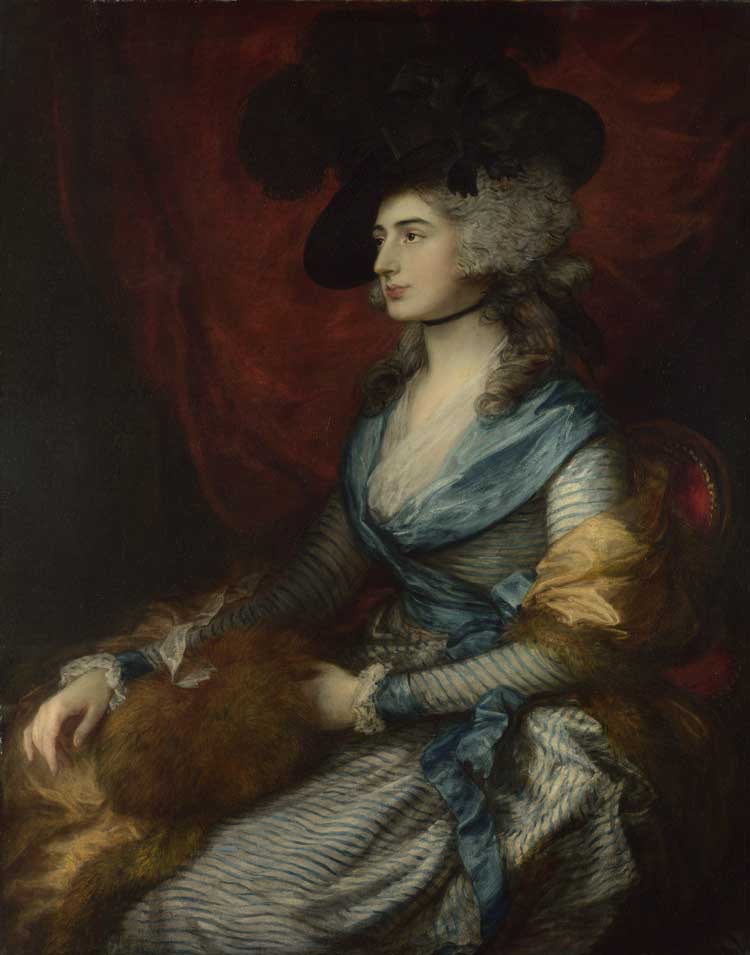
Thomas Gainsborough. Mrs Siddons, 1785. Oil on canvas, 126 × 99.5 cm. The National Gallery, London. Bought, 1862. © The National Gallery, London.
Gainsborough was undoubtedly claiming the legacy of Van Dyck – in costume (though “Van Dyck dress” was popular in theatre and at lavish balls in Gainsborough’s time), pose and painterly virtuosity, but whether in contradiction of Reynolds is unclear. The two artists did, however, exemplify different approaches and Gainsborough’s Mrs Siddons (1785) that hangs with the Blue Boy in this exhibition, depicts the famous actress not in character or costume but firmly as herself, in contrast (perhaps deliberate) to Reynolds’ Sarah Siddons as the Tragic Muse, painted a year earlier. This picture hung with Blue Boy, and Gainsborough’s Mrs Siddons (owned, then as now, by the National Gallery) at the farewell exhibition in 1922, as the Reynolds had also been sold to the Huntingtons.
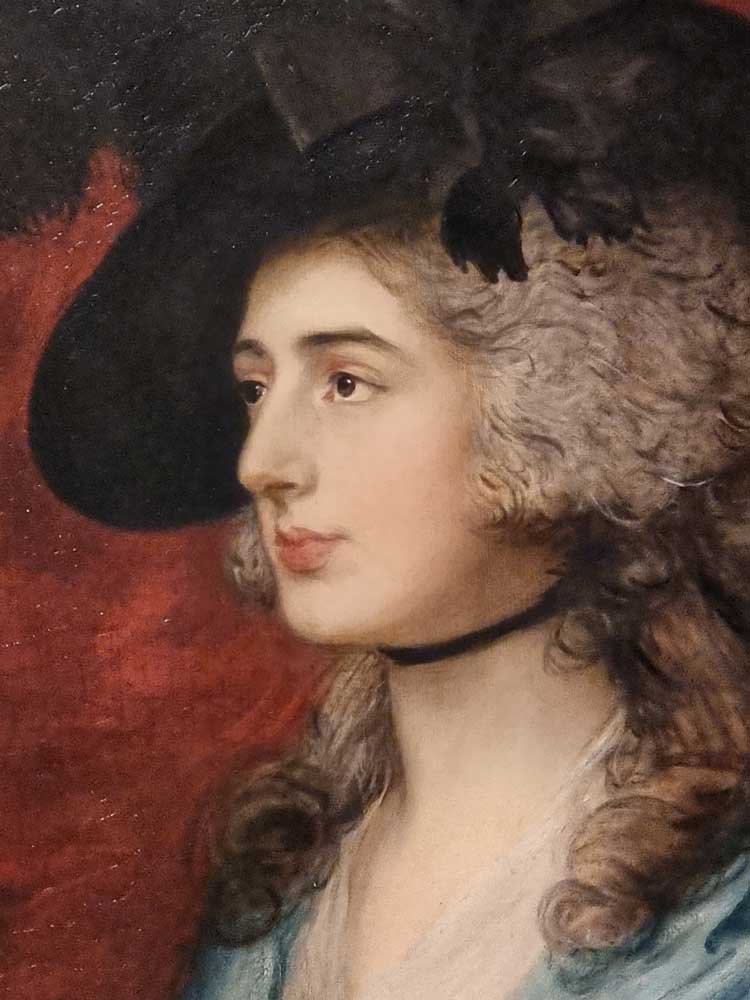
Thomas Gainsborough. Mrs Siddons, 1785 (detail). Oil on canvas, 126 × 99.5 cm. The National Gallery, London. Photo: Juliet Rix.
Gainsborough’s Mrs Siddons, in which the dominant colour of the clothing is once again blue (though against a rich theatre-curtain-red background), shows the actress as a poised contemporary woman, gazing steadily across the canvas. In this setting, she is looking towards two more confident performers, professional singers Elizabeth and Mary Linley, portrayed by Gainsborough shortly after the Blue Boy (with some retouching to update the hair and clothing at the request of the family in 1785).
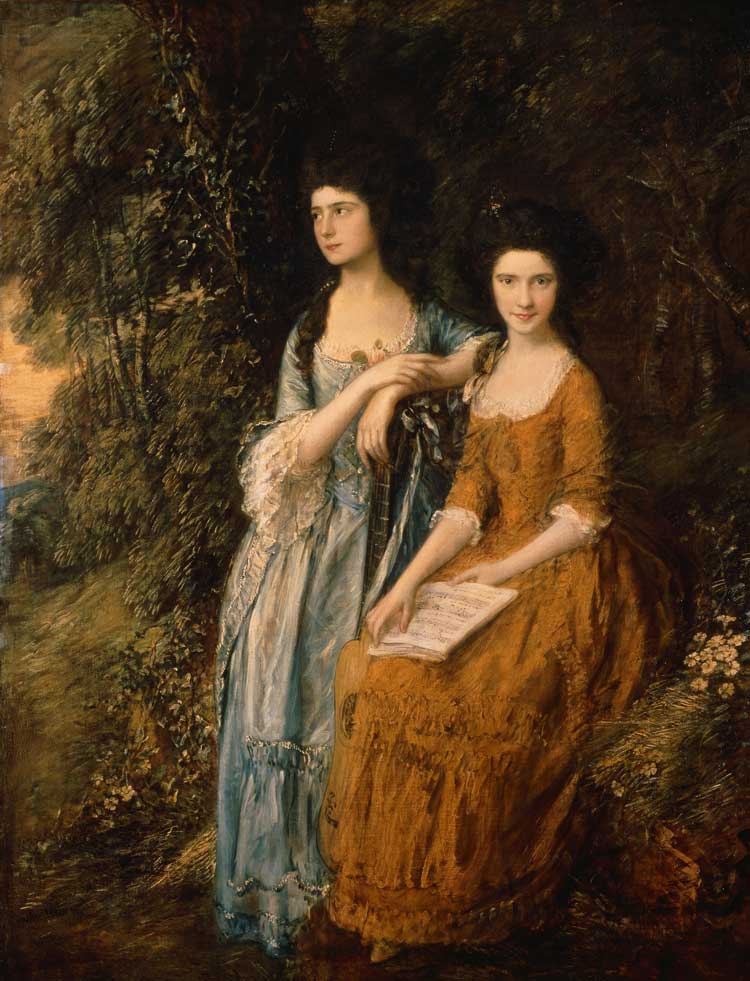
Thomas Gainsborough. Elizabeth and Mary Linley, about 1772, retouched 1785. Oil on canvas, 199 × 153.5 cm. Dulwich Picture Gallery, London. © By Permission of the Trustees of the Dulwich Picture Gallery, London
Mary Linley, seated, looks out at us as directly as the Blue Boy and without the uncertainty, while her sister glances off to our left. The composition almost certainly owes something to Van Dyck’s sibling double portrait, which hangs opposite. This is Lord John Stuart and his Brother, Lord Bernard Stuart (c1638), a picture Gainsborough is known to have admired. He made a full copy of it sometime in the 1760s and the shimmering blue of Bernard Stuart’s satin trousers provides an obvious link to the Blue Boy.

Anthony van Dyck. Lord John Stuart and his Brother, Lord Bernard Stuart, about 1638. Oil on canvas, 237.5 x 146.1 cm. The National Gallery, London. Bought, 1988. © The National Gallery, London.
The Boy owes an equally clear debt to the other Van Dyck in the room, the 1638 double portrait of the young Villiers brothers (George Villiers, 2nd Duke of Buckingham, and Lord Francis Villiers).
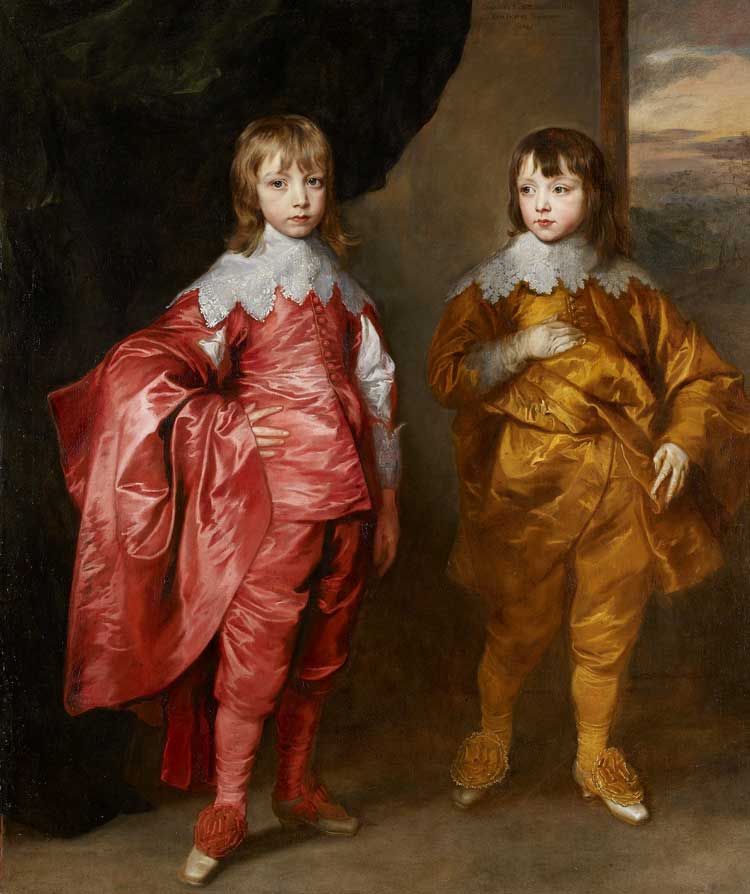
Anthony van Dyck. George Villiers, 2nd Duke of Buckingham and Lord Francis Villiers, 1635. Oil on canvas, 137.2 × 127.7 cm. The Royal Collection / HM Queen Elizabeth II. Royal Collection Trust / © Her Majesty Queen Elizabeth II 2022.
The Blue Boy’s pose is a mirror image of that of George Villiers. His look though is quite different. The Villiers children are very young, a little melancholy, and not imbued with any great sense of character behind the eyes. The Blue Boy, on the other hand, though his clothes (and even his hairstyle) are pure performance, stares out at us, energetically rosy-cheeked, with a very credible mix of youthful assertiveness and youthful uncertainty.
He can be read as a self-assured innocent on the cusp of an unknown adulthood, and this was how many saw him a century ago, a time when such an image carried particular poignancy. January 1922 was only a little over three years after the end of the first world war, during which the nation had lost about 800,000 men, most of them young, and seen hundreds of thousands more return wounded. And it was only just over a year since the unveiling of the Cenotaph as a permanent memorial, and the solemn entombment of the Unknown Warrior, both just a few hundred metres from the National Gallery down Whitehall.
The connection was made by the press at the time – another boy was leaving these shores, likely never to return. “Absurdly enough, perhaps,” said the Times, “one or two of us had tears in our eyes.” The paper went on to suggest that the painting represented a loss of a more innocent, a more certain, time. There was nothing very innocent, or particularly certain, about the 18th century, of course, but as is so often the case, this was less about the time of the painting, more about the seductive nature of romantic nostalgia in the very disrupted time of the viewers.
Britain was struggling, while the US was in the ascendant. Its new millionaires had money to burn and a strong desire to prove their cultural as well as financial dominance. In Britain, neither private nor public institutions – not even the National Art Collections Fund, set up in 1903 precisely to prevent the loss of masterpieces abroad – could afford to compete with the likes of the Fricks, Mellons and Huntingtons.
This had been the case even before the war, as American-British writer Henry James’s reflected in his 1911 novel The Outcry, in which a wealthy American tries to buy a Reynolds portrait from a British aristocrat against vocal opposition from the public. The book ends with the painting withdrawn from sale and two other important pictures (including a Thomas Lawrence) being donated to the National Gallery. Fact followed fiction as far as the outcry, but not the outcome; Blue Boy set sail across the Atlantic.
Thanks in part to Duveen’s extraordinary marketing skills, the painting’s popularity travelled with it. On show for three weeks at his New York gallery, it gained almost as much attention as it had in London. Then it was off again, to the Huntingtons’ ranch in San Marino, California, soon to be opened to the public as The Huntington Library, Art Museum and Botanical Gardens.
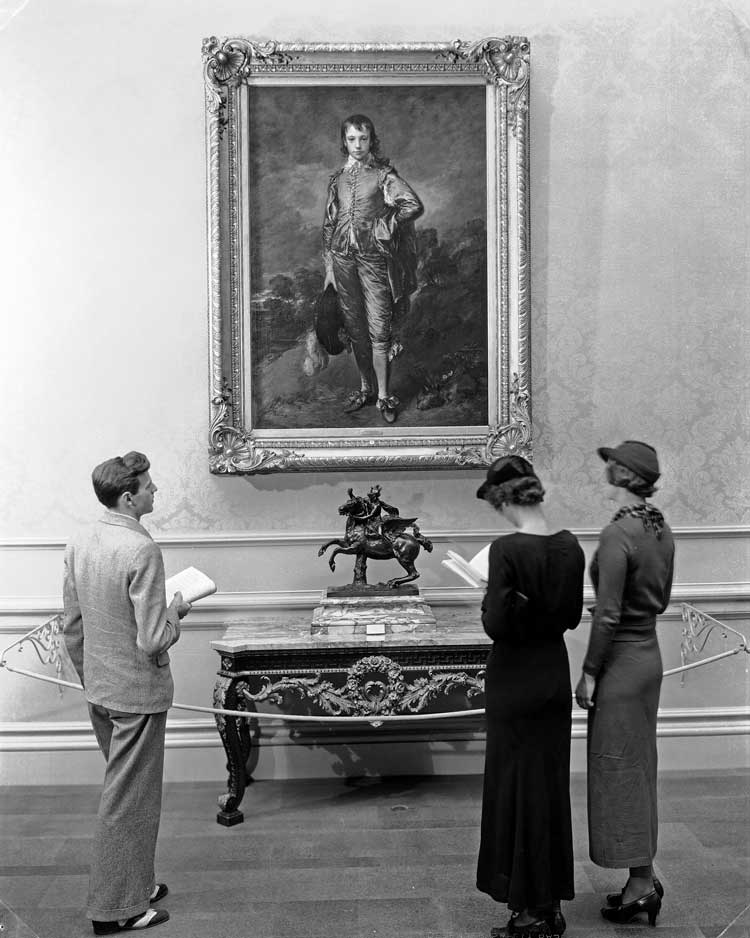
Early visitors to the Huntington Art Gallery, c1935. Photo © courtesy of the Huntington Library, Art Museum, and Botanical Gardens, San Marino, California.
The Blue Boy graced 20th-century American walls, mantelpieces and cookie tins, just as it had British 19th-century homes, and it even made its way into Hollywood films, alongside Laurel and Hardy, Batman and James Bond. It remained a painters’ painting, too, referenced by artists as diverse as Whistler, Peter Blake, Robert Rauschenberg and Kehinde Wiley.
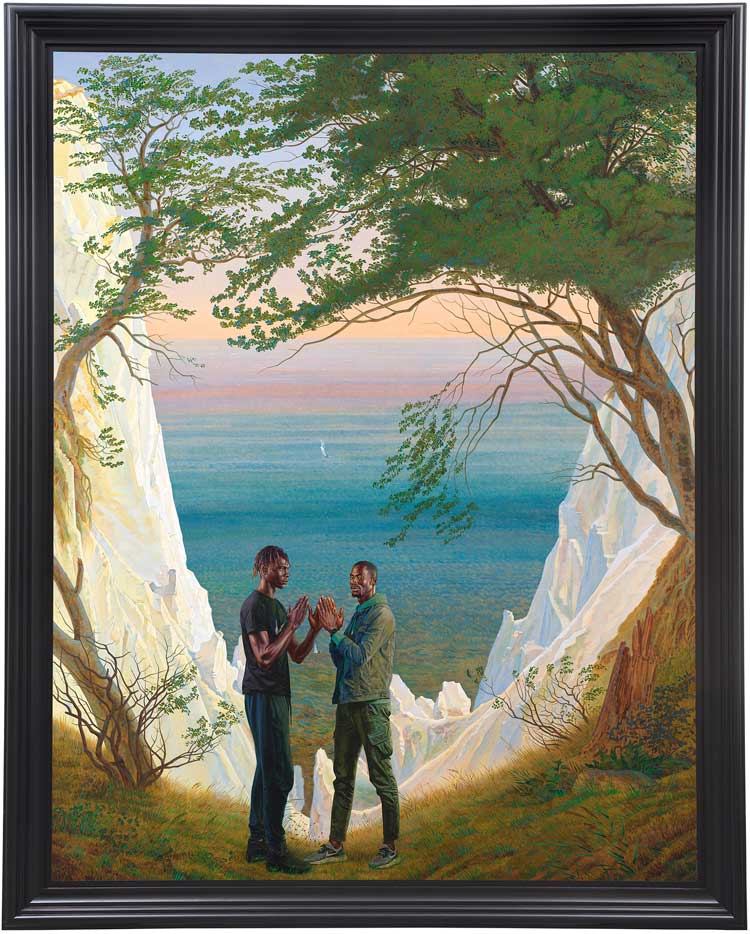
Kehinde Wiley. Prelude (Ibrahima Ndiaye and El Hadji Malick Gueye), 2021. Oil on linen, 387.2 × 305 cm. © Kehinde Wiley. Courtesy of Stephen Friedman Gallery, London and Galerie Templon, Paris.
Wiley was, in fact, commissioned by the Huntington to paint a 21st-century take on the Blue Boy for the centenary of its purchase (A Portrait of a Young Gentleman, 2021). This is not at the National Gallery, but a small Wiley exhibition is (until 18 April 2022). It is worth dropping in, particularly to look at his powerful double portrait, Prelude (Ibrahima Ndiaye and El Hadji Malick Gueye), 2021. As with many of Wiley’s portraits, he has taken an historic painting and reworked it. In this case it is Caspar David Friedrich’s Chalk Cliffs on Rügen (1818-19).
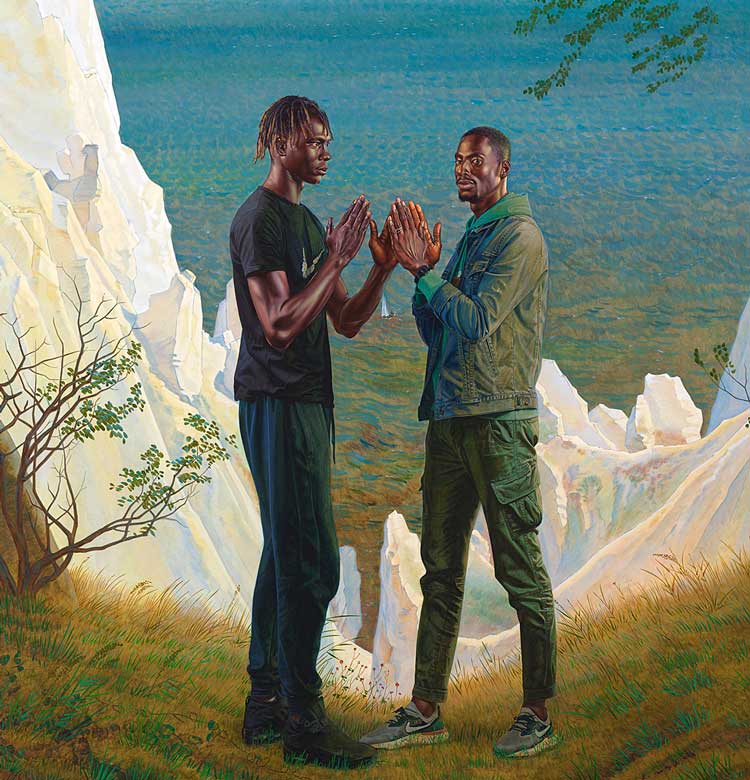
Kehinde Wiley. Prelude (Ibrahima Ndiaye and El Hadji Malick Gueye), 2021 (detail). Oil on linen, 387.2 × 305 cm. © Kehinde Wiley. Courtesy of Stephen Friedman Gallery, London and Galerie Templon, Paris.
The idealised landscape owes everything to Friedrich, but the human figures almost nothing. Two black men stand strongly together at the centre of the composition. Connected through their hands (which play a clapping game), one stares straight out at us, the other looks across at him. They seem to owe more to the British portraits temporarily hanging in the room across the corridor, than to any 19th-century German.
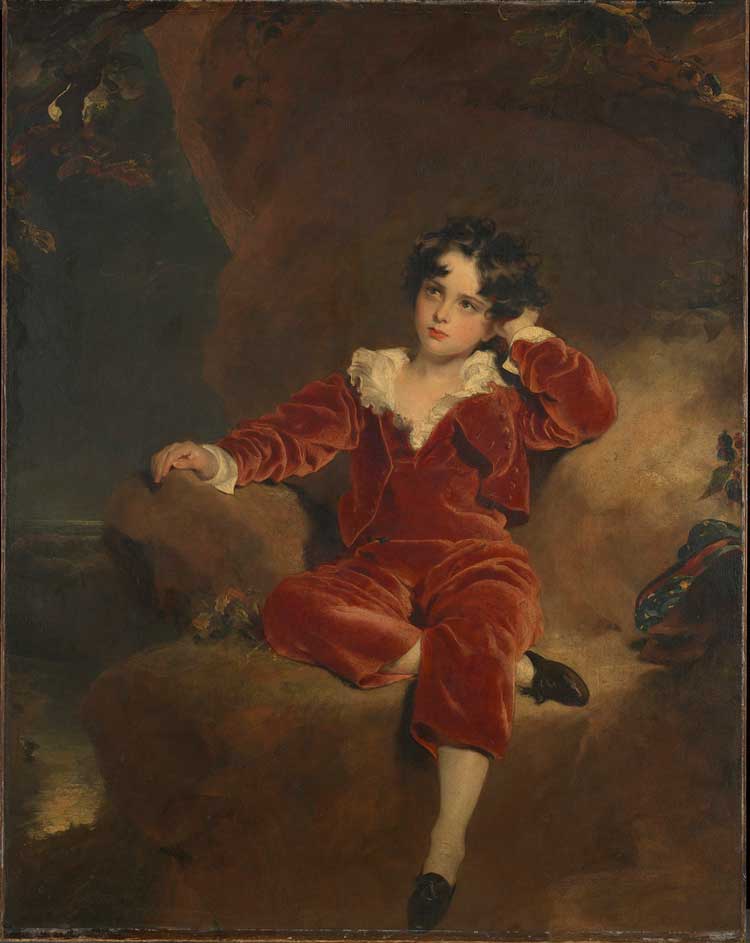
Sir Thomas Lawrence. Charles William Lambton, 1825. 137.2 x 111.8 cm. Private collection. Image © National Gallery, London.
The National Gallery offers art historical context, too, with an online Blue Boy Trail that takes visitors beyond the one room temporary exhibition into the permanent collection. The 10 trail pictures include Titian’s Bacchus and Ariadne, named in Reynolds’ discourse, as well as Thomas Lawrence’s The Red Boy (Portrait of Charles William Lambton, 1825), which the National Gallery acquired last year. Duveen tried to sell this portrait as the next Blue Boy but failed. Though a charming picture, with the achingly sweet child robed in luscious red velvet, the Red Boy has none of the arresting directness, let alone ambiguity, of its cooler-coloured predecessor.
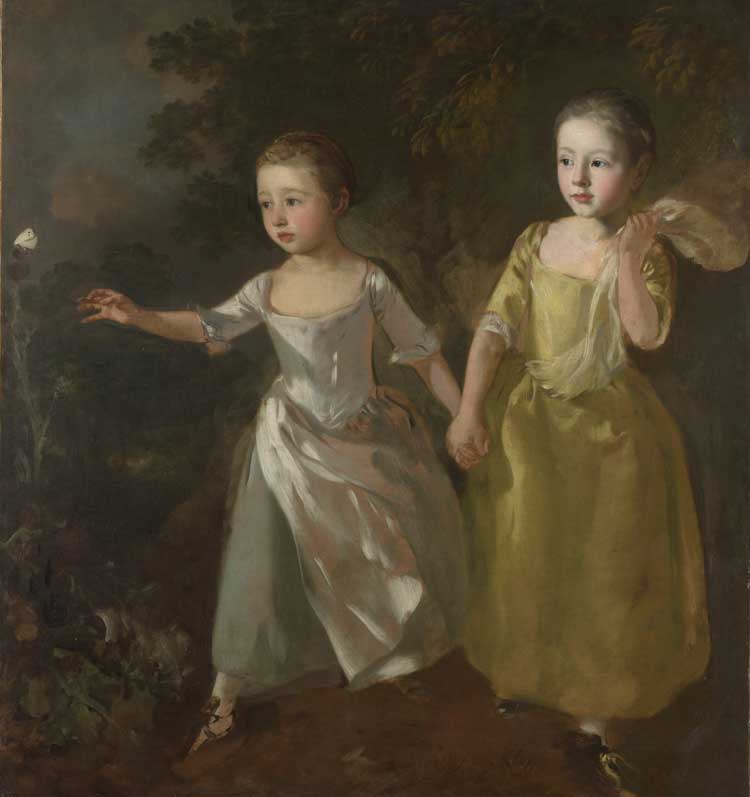
Thomas Gainsborough, The Painter's Daughters chasing a Butterfly, about 1756. Installation view. Photo: Juliet Rix.
There are several more Gainsboroughs on the trail, including the wonderfully affectionate portrait of his daughters chasing a butterfly, and the depressingly wooden Mr and Mrs Andrews. The latter does at least serve to show just how far the artist came in the 20 years between this picture and the Blue Boy. There is a little pilgrimage of place here, too: these two Gainsborough portraits still hang in Room 34, almost certainly the room in which the Blue Boy received his final visitors before leaving for America.
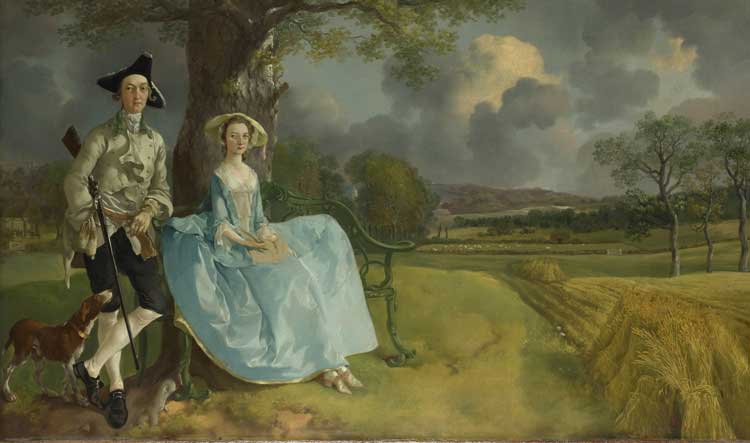
Thomas Gainsborough, Mr and Mrs Andrews c1750. Oil on canvas, 69.8 cm × 119.4 cm (27.5 in × 47.0 in). © The National Gallery, London.
Gainsborough’s Blue Boy has not left California since – until now. The ghost of Sir Charles Holmes must be smiling down. In the recent restoration, the gallery director’s hopefully inscribed “Au Revoir” was carefully preserved, and as today’s director, Gabriele Finaldi, opened the exhibition, he promised not to write on the painting. The Huntington’s conservator, standing behind him responded: “Please don’t!” But as we chatted afterwards, I wondered aloud: “Wouldn’t it be good for him to write something? Isn’t this return visit part of the Blue Boy’s story?” “Maybe,” she said, “perhaps we can find a way …”